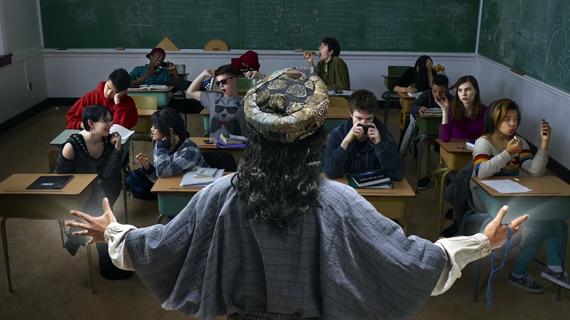If you’ve ever wondered whether the art of photography could motivate folks to examine their own world views (or at the very least, make a big stir), Canadian photographer and pop surrealist Dina Goldstein could probably give you some tips. She’s recently opened her third large-scale photo project, Gods of Suburbia, and it guarantees to make you stop and think. Here’s a behind-the-scenes look at how it came about:
Like Goldstein’s other controversial work (Fallen Princesses and In the Dollhouse), Gods Of Suburbia juxtaposes the mundane and everyday with cultural archetypes to inspire insight into the human condition. As the name suggests, Gods of Suburbia places well-known and highly-revered deities into a suburban backdrop of modern (Western) society. In doing so, she transforms them into characters that “are able to live and function as we do — and also experience the real human condition where they suffer and they find themselves contemplating their place in this world as we do.”
The full series encompasses 11 different scenarios including gods and goddesses from a number of different religions—even Scientology.

Mohammed teaching at a modern-day high school.
Part of Dina’s fascination with religion centers around what happens when East meets West. Muhammad the Prophet was intended to be an exploration into the obvious disconnect between the East—specifically Islamic principles—and the West’s secular ideals.

Jesus in a modern day, suburban last supper.
This re-imagining of the Last Supper is definitely one of the more arresting photographs. Inspired by Da Vinci’s iconic painting, Goldstein places Jesus and his apostles in Vancouver’s downtown Eastside. (For those of you who don’t know, Vancouver’s Eastside is one of Canada’s poorest postal codes and is privy to extensive drug abuse, alcohol addictions, and mental illness.) Her intention with the photo was to “portray the treatment of the most vulnerable” members of society.
If the photos seem complex, well, they are. Large productions like this entail a lot of equipment, staff, and planning (in short, a large budget), but the results are worth it. Whether you agree with her choices or not, the work speaks for itself.
Ultimately, Goldstein hopes her Gods of Suburbia series “will open a reasonable conversation about religion today,” but already it’s garnered criticism. Included in the series are the Hindu gods Ganesh and Lakshmi, and some Hindus say they are wrongfully represented.
“Ganesh and Lakshmi and other Hindu deities were meant to be worshiped in temples and home shrines and it was not appropriate to unnecessarily drag them around to push your personal interests,” says Rajan Zed, president of the Universal Society of Hinduism.
Dina’s response?
“If you look at it rationally, there is no reason why people’s beliefs are not open for debate. Religion hides behind ideas that are considered ‘sacred and holy.’ The problem is that there are so many doctrines and sub doctrines existing today, with everyone thinking that their belief is omnipotent. Organized belief has always been divisive on a global scale.”
What do you think? Are their some topics too sacred to touch?
Like This Article?
Don't Miss The Next One!
Join over 100,000 photographers of all experience levels who receive our free photography tips and articles to stay current:







Leave a Reply